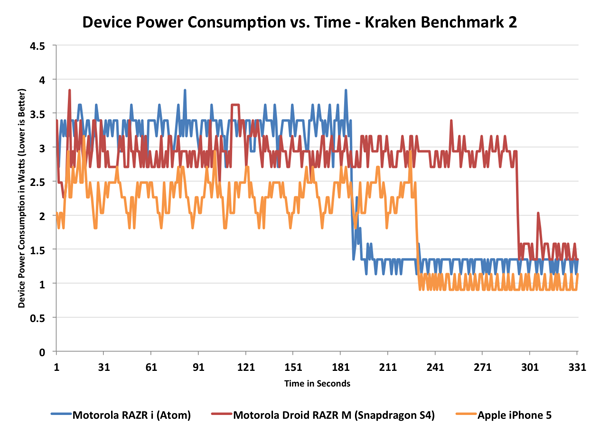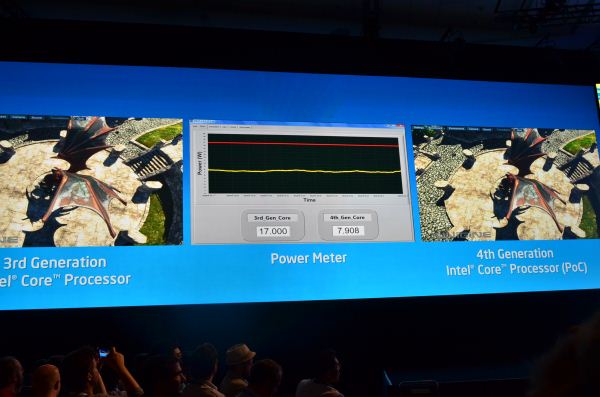The ARM vs x86 Wars Have Begun: In-Depth Power Analysis of Atom, Krait & Cortex A15
by Anand Lal Shimpi on January 4, 2013 7:32 AM EST- Posted in
- Tablets
- Intel
- Samsung
- Arm
- Cortex A15
- Smartphones
- Mobile
- SoCs
Final Words
Whereas I didn't really have anything new to conclude in the original article (Atom Z2760 is faster and more power efficient than Tegra 3), there's a lot to talk about here. We already know that Atom is faster than Krait, but from a power standpoint the two SoCs are extremely competitive. At the platform level Intel (at least in the Acer W510) generally leads in power efficiency. Note that this advantage could just as easily be due to display and other power advantages in the W510 itself and not necessarily indicative of an SoC advantage.
Looking at the CPU cores themselves, Qualcomm takes the lead. It's unclear how things would change if we could include L2 cache power consumption for Qualcomm as we do for Intel (see page 2 for an explanation). I suspect that Qualcomm does maintain the power advantage here though, even with the L2 cache included.
On the GPU side, Intel/Imagination win there although the roles reverse as Adreno 225 holds a performance advantage. For modern UI performance, the PowerVR SGX 545 is good enough but Adreno 225 is clearly the faster 3D GPU. Intel has underspecced its ultra mobile GPUs for a while, so a lot of the power advantage is due to the lower performing GPU. In 2D/modern UI tests however, the performance advantage isn't realized and thus the power advantage is still valid.
Qualcomm is able to generally push to lower idle power levels, indicating that even Intel's 32nm SoC process is getting a little long in the tooth. TSMC's 28nm LP and Samsung's 32nm LP processes both help silicon built in those fabs drive down to insanely low idle power levels. That being said, it is still surprising to me that a 5-year-old Atom architecture paired with a low power version of a 3-year-old process technology can be this competitive. In the next 9 - 12 months we'll finally get an updated, out-of-order Atom core built on a brand new 22nm low power/SoC process from Intel. This is one area where we should see real improvement. Intel's chances to do well in this space are good if it can manage to execute well and get its parts into designs people care about.

Device level power consumption, from our iPhone 5 review, look familiar?
If the previous article was about busting the x86 power myth, one key takeaway here is that Intel's low power SoC designs are headed in the right direction. Atom's power curve looks a lot like Qualcomm's, and I suspect a lot like Apple's. There are performance/power tradeoffs that all three make, but they're all being designed the way they should.
The Cortex A15 data is honestly the most intriguing. I'm not sure how the first A15 based smartphone SoCs will compare to Exynos 5 Dual in terms of power consumption, but at least based on the data here it looks like Cortex A15 is really in a league of its own when it comes to power consumption. Depending on the task that may not be an issue, but you still need a chassis that's capable of dissipating 1 - 4x the power of a present day smartphone SoC made by Qualcomm or Intel. Obviously for tablets the Cortex A15 can work just fine, but I am curious to see what will happen in a smartphone form factor. With lower voltage/clocks and a well architected turbo mode it may be possible to deliver reasonable battery life, but simply tossing the Exynos 5 Dual from the Nexus 10 into a smartphone isn't going to work well. It's very obvious to me why ARM proposed big.LITTLE with Cortex A15 and why Apple designed Swift.
I'd always heard about Haswell as the solution to the ARM problem, particularly in reference to the Cortex A15. The data here, particularly on the previous page, helped me understand exactly what that meant. Under a CPU or GPU heavy workload, the Exynos 5 Dual will draw around 4W. Peak TDP however is closer to 8W. If you remember back to IDF, Intel specifically called out 8W as a potential design target for Haswell. In reality, I expect that we'll see Haswell parts even lower power than that. While it may still be a stretch to bring Haswell down to 4W, it's very clear to me that Intel sees this as a possiblity in the near term. Perhaps not at 22nm, but definitely at 14nm. We already know Core can hit below 8W at 22nm, if it can get down to around 4W then that opens up a whole new class of form factors to a traditionally high-end architecture.
Ultimately I feel like that's how all of this is going to play out. Intel's Core architectures will likely service the 4W and above space, while Atom will take care of everything else below it. The really crazy part is that it's not too absurd to think about being able to get a Core based SoC into a large smartphone as early as 14nm, and definitely by 10nm (~2017) should the need arise. We've often talked about smartphones being used as mainstream computing devices in the future, but this is how we're going to get there. By the time Intel moves to 10nm ultramobile SoCs, you'll be able to get somewhere around Sandy/Ivy Bridge class performance in a phone.
At the end of the day, I'd say that Intel's chances for long term success in the tablet space are pretty good - at least architecturally. Intel still needs a Nexus, iPad or other similarly important design win, but it should have the right technology to get there by 2014. It's up to Paul or his replacement to ensure that everything works on the business side.
As far as smartphones go, the problem is a lot more complicated. Intel needs a good high-end baseband strategy which, as of late, the Infineon acquisition hasn't been able to produce. I've heard promising things in this regard but the baseband side of Intel remains embarassingly quiet. This is an area where Qualcomm is really the undisputed leader, Intel has a lot of work ahead of it here. As for the rest of the smartphone SoC, Intel is on the right track. Its existing architecture remains performance and power competitive with the best Qualcomm has to offer today. Both Intel and Qualcomm have architecture updates planned in the not too distant future (with Qualcomm out of the gate first), so this will be one interesting battle to watch. If ARM is the new AMD, then Krait is the new Athlon 64. The difference is, this time, Intel isn't shipping a Pentium 4.











140 Comments
View All Comments
gryer7421 - Friday, January 4, 2013 - link
aaaand then looses where it matters, the rest of the platform. one more process shrink and both will be on even terms in cpu power usage and then as a whole platform will start punching arm in the face.Wolfpup - Friday, January 4, 2013 - link
Huh? Did you read the article? Atom built on 32nm is competitive with ARM built on 28nm. Not only that, but it's looking like Haswell will realistically be able to compete here too, and we've got the second gen Atom coming up this year too...but TODAY'S Atom at an older process is competitive with ARM...what you're claiming is exactly the opposite of what the article says.JumpingJack - Friday, January 4, 2013 - link
I don't think we are looking at the same data, overall Atom appears to uses the same or less power than Krait and offers better performance in general.Homeles - Friday, January 4, 2013 - link
"Anyone with half a brain" would read the article before making such an idiotic statement.Rezurecta - Saturday, January 5, 2013 - link
wow. Way to belittle Anand's hard work...Great article! One of the many reasons I love this site. :)
Death666Angel - Friday, January 4, 2013 - link
The Star Wars theme to play in my head! Thanks for that! :DDeath666Angel - Friday, January 4, 2013 - link
"I wonder what an 8W Haswell would look like in a similar situation."Me too. However, considering that they 17W ULV parts only reach those numbers by throttling as well, I don't expect a lot.
carancho - Friday, January 4, 2013 - link
Amazing work. Congratulations! A couple of presentation suggestions:Next time please smooth some of the most important charts. The volatility makes it hard to see where the averages are. Take this chart: http://images.anandtech.com/reviews/SoC/Intel/CTvK... it could really benefit to have another copy with some additional smoothing.
Also, in power charts like this http://images.anandtech.com/reviews/SoC/Intel/CTvK... it would be helpful to have as a summary followup chart the power calculation done and presented as bar charts; otherwise we have to resort to calculate the differences in the areas below the lines with our eyes, and they can be deceiving.
carancho - Friday, January 4, 2013 - link
I hadn't reached the A15 part yet when writing this. Ignore the 2nd comment.amorlock - Friday, January 4, 2013 - link
I'm frankly amazed and impressed that Intel can get Haswell down to 8W but it's hard to imagine it in a mid range mobile device because of the likely unit cost. The reason Atom has stagnated until recently is because Intel doesn't want to create a chip that cuts into it's very profitable mainstream CPU market.